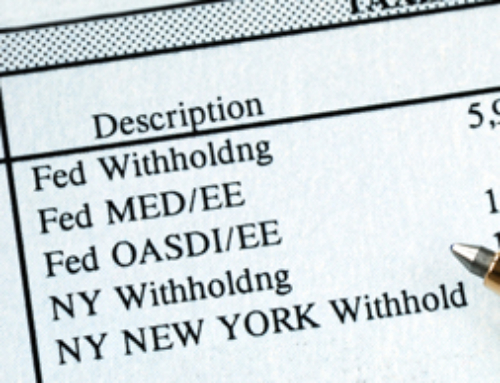
Payroll Withholding Tax: Reevaluating Withholding for 2011
January dawns all fresh and clean.
All our financial errors, oversights, and misjudgments from last year can be swept away (though we may still have to pay for our ills…), and we get to start this year with a clean slate.
What’s the best way to start off correctly when you’re an employee?
Reevaluate your payroll withholding tax and update your Form W-4 with your payroll department early in the year. Spread your tax burden evenly throughout the year to avoid large balances due come April.
How much do you have to withhold from your paycheck in order to avoid any penalties and interest?
Target $1,000
You have two options:
- Pay in enough so you owe less than $1,000 in tax for 2011, after subtracting your withholding and refundable credits.
- Set up your withholding and refundable credits so you pay in more than the smaller of:
- 90 percent of the tax to be shown on your 2011 tax return, or
- 100 percent of the tax shown on your 2010 tax return (or 110 percent when income is over $150,000). Your 2010 tax return must cover all twelve months.
Generally, if you set up your withholding so you never owe $1,000 on April 15, you will avoid all penalties.
Huge Refund Strategy
Some of my favorite clients prefer to receive several thousand dollars worth of refunds. It’s their idea of an enforced savings plan. Do you do that, too?
Is it a good idea?
Back in the 1980s, when banks gave you a toaster and a minimum 5 percent interest on your passbook savings—no, it was not a good idea. Money market accounts were paying 10 to 20 percent with little or no risk.
Today, when you’re lucky to get a 1 percent rate of return on a one-year CD, you may just as well leave it with the IRS.
Drawback: You must wait until you file your tax return to get your hands on the money.
Injured Spouse Payroll Withholding Strategy
Perhaps you’re facing this sad situation, having married someone who owes back taxes to the IRS or the state, back child support—being collected from tax refunds—or other debt that the IRS or your state is collecting by grabbing your joint refunds.
Avoid the IRS taking your share of the refund by filing either with married filing separately (MFS) status or with a joint return and trying to get the IRS to accept your injured spouse claim on Form 8379. You may have to fight for your share of the refund—or wait months to get the money back.
Or…simply reduce your withholding so you end up paying $100 or so, instead of getting a refund. To still build up your savings, put part of your paycheck into a separate bank account without your spouse’s name on it.
Easy Fixes for Payroll Withholding Tax
What else should you do with the payroll department? If these services are available, establish automatic deposits and review insurance payments, union fees, and other routine deductions to see if they are outdated. And please, don’t forget the automatic deductions to your favorite charity.

Read More:
Tax Schemes and Tax Turkeys: Stay Away from Too-Good-to-Be-True Tax Advice
Winner! Winner! Winner!: Tax Implications of Winning Lotteries and Game Show Prizes
New Tax Laws for 2011
Open-Enrollment and FSAs: A Bonanza of Tax Advantages






